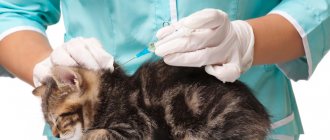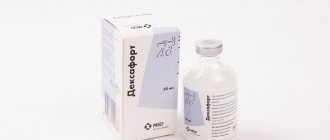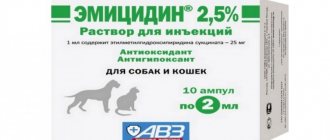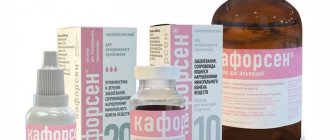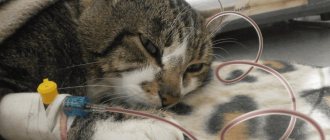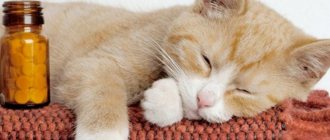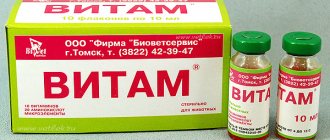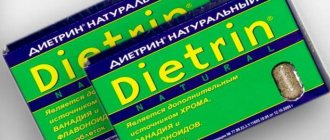INDICATIONS
Cobactan has antibiotic activity against common bacteria in dogs and cats, including gram-positive:
- Staphylococcus aureus
- Streptococcus dysgalactiae
- Streptococcus uberis
- Corynebacterium
Gram-negative:
- Salmonella
- Escherichia coli
- Actinobacillus pleuropneumoniae
- Haemophilus
- Pasteurella
- Klebsiella
- Proteus mirabilis
Cobactan is prescribed to cats and dogs for:
- Respiratory diseases
- Purulent dermatitis
- Pleurisy
- peritonitis
- Purulent wounds
- Encephalitis
- cholangitis
- Enteritis
Pharmacological properties
Cefkin has a wide spectrum of action on both gram-positive and gram-negative bacteria, including Pasteurella spp., E. coli, Salmonella spp., Staphylococcus spp., Streptococcus spp., Corynebacterium spp., Clostridium spp. The therapeutic level of cefkin in organs and tissues is achieved within a few minutes. Particularly high levels are observed in bronchial mucus. Cefkin is characterized by very high stability against beta-lactamases. Resistance does not develop against cefkinome due to its mechanism of action. Cefkin has a strong binding property to special receptors on the bacterial wall, which contributes to the rapid manifestation of its bactericidal properties. Cefkin is excreted by the kidneys.
PRECAUTIONARY MEASURES
Penicillins and cephalosporins may cause hypersensitivity (allergy) after injection, inhalation, ingestion or skin contact. Hypersensitivity to penicillins may lead to cross-sensitivity to cephalosporins and vice versa. Allergic reactions to these substances can sometimes be serious.
- Do not handle this product if you know you have a sensitivity or have been advised not to handle this product.
- Handle this product with great care to avoid complications by following all recommended precautions.
- If you develop symptoms following exposure, such as skin rash, you should contact your doctor and show your doctor this warning. Swelling of the face, lips or eyes or difficulty breathing are more serious symptoms and require urgent medical attention.
- Unused contents may be disposed of in a suitable landfill. See Safety Data Sheet for more information.
Contraindications and negative reactions
The manufacturer claims that Cobactan is prohibited from being administered to animals that have an individual intolerance to substances from its composition. It is also undesirable to use an antibiotic if the cat is expecting or breastfeeding its offspring.
There are no other restrictions on the use of the medication. However, before treating sick, weakened and small animals, it is imperative to talk to a veterinarian.
A painful lump often appears in the injection area . In most cases, it goes away on its own and does not require specific treatment. There are no other side effects associated with the use of the antibiotic.
If a cat has allergic manifestations, it needs to be given an anti-allergy drug as soon as possible.
PRUDENT USE
It is prudent to reserve this cephalosporin product for the treatment of clinical conditions that have responded poorly to other classes of antimicrobials. Use of the product should be based on susceptibility testing of bacteria isolated from the individual animal to be treated. Indiscriminate use of antimicrobials may contribute to the development of antibiotic resistance.
- Kobaktan is a registered trademark.
How does the medicine work?
The mechanism of the bactericidal effect of the drug is to disrupt the synthesis of bacterial cell membranes.
After parenteral administration (injection), the active substance, cefkin, enters the bloodstream, reaches its maximum concentration in the blood serum and subsequently remains at a therapeutic level throughout the day.
Due to its bipolar structure, cobactan easily penetrates the cell of a microorganism. Since a low concentration of the active substance is sufficient to effectively influence bacteria, the drug is low toxic.
The positive characteristics of this drug also include the fact that it is able not only to rid the animal of the underlying disease, but also at the same time fights concomitant infections and inflammatory processes in the body.
That is why the drug is preferred in difficult cases, as well as in those moments when it is impossible to accurately determine the cause of the disease.
Cefkin is excreted mainly in the urine unchanged.
Side effects of cobactan in cats and dogs
Symptoms of drug overdose in small pets have not been identified.
Side effects and complications when using Cobactan in accordance with these instructions, as a rule, are not observed. In some animals, a local reaction in the form of edema may occur at the injection site, which spontaneously resolves within 10-15 days.
In case of increased individual sensitivity to the drug and the manifestation of allergic reactions, the animal is prescribed antihistamines and symptomatic therapy.
No peculiarities of action were identified during the first administration of the drug and upon its withdrawal. Cobactan should not be used simultaneously with bacteriostatic drugs due to a decrease in its bactericidal activity.
Instructions for use
Since Cobactan is quite expensive, it is better to take your pet to a clinic where the veterinarian will give him the injection himself. You can, of course, buy the drug yourself, but its course lasts only 3-5 days and the injection is administered once a day. During this time, the 50 ml bottle will not be able to be used completely, and four weeks after opening the medicine will no longer be suitable for use and will have to be thrown away.
Kobaktan has several of its own features:
- To avoid tissue swelling, it is better to change the injection site every time;
- Although in the case of small overdoses there are no dire consequences, it is still very important to calculate the correct dosage based on the animal’s body weight and its illness. Usually 0.1 ml is prescribed per 1 kg of weight;
- It is advisable to give injections at approximately the same time, so that there is a time interval of 24 hours.
Learn about essential antimicrobials in animals
- Doxilox in animals
- Instructions: amoxifarm in animals and birds
- Use of chlorhexidine in dogs
- Amprosid in birds
- Chlorhexidine in cats
- Use of ditrim in animals
- Instructions for the use of bactyl in animals. Calculate the optimal dose of the drug in pigs, cattle, calves, piglets, cats and dogs
- Instructions for the use of chlorhexidine in humans, animals and birds
- Furacilin in dogs, cats, cows
- Instructions for the use of dioxinor in dogs, cats, piglets, calves, horses
- Instructions for the use of disparkol in dogs, cats, piglets, calves, horses
- Instructions for the use of norfloxacin in dogs, cats, piglets, calves, horses
- Instructions for the use of dienomast in cows
- Instructions for use of furazolin in humans and dogs
- Instructions for the use of furagin in cats, dogs, cattle, pigs, horses and other species of animals
- Instructions for the use of diarcan in animals
- Instructions for the use of sodium sulfacyl in cats, dogs, cattle, pigs, horses and other species of animals
- Instructions: furadonin in cats, dogs and other species of animals
- Instructions: sulfapyridazine in cats, dogs, cattle, pigs, horses and other species of animals
- Phenol in cats, dogs, cattle, pigs, horses and other species of animals
- Instructions: furazolidone in cats, dogs, cattle, pigs, horses and other species of animals
- Instructions: Phtazol in cats, dogs and other species of animals
- Instructions for the use of diarcan in dogs
- Vaccamast in animals
- Instructions for the use of vetrimoxine in animals
- Instructions: gentam in animals
- Instructions for use of gentaprim in animals
- Geovet in ruminants
- Instructions: Viapen in animals
- Instructions: denagard in animals
- Instructions for the use of hydroxine in animals
- Amoxoil in animals
- Instructions: amoxoil in cats
- Instructions for use of amoxisan in cats
- Aamoxisan in animals
- Instructions for the use of amoximag in cats, dogs, cattle, pigs, horses and other species of animals
- Instructions for use of biovit a 80 in animals and birds
- Tylosin in chickens and turkey poults
- Instructions for use of tylosin-50 in cats
- Instructions for use of tylosin in dogs
- Use of tylosin in animals
- Instructions for the use of tylosin in cows
- Sulfadimezin in cats and dogs
- Use of sulfadimethoxine in cats and dogs
- Instructions for the use of sulfazine in cats and dogs
- Instructions for the use of amoxigard in cats, dogs, cattle, pigs, horses and other species of animals
- Instructions for the use of azitronite in cats, dogs, cattle, pigs, horses and other species of animals
- Sulfamonomethoxin in cats and dogs
- Amoxilong in cats, dogs and other animal species
- Instructions for the use of sulfalene in cats and dogs
- Instructions for the use of albipen in cats, dogs, cattle, pigs, horses and other species of animals
- Lead acetate
- Instructions: streptomycin in veterinary medicine
- Sulgin in cats and dogs
- Instructions for use of Azikana in cats and dogs
- Septonex
- Streptocide in cats and dogs
- Instructions for use of Unidox in dogs
- Unidox in cats
- Use of 3% hydrogen peroxide solution in veterinary medicine
- Instructions for use of Lugol's solution in veterinary medicine
- Use of Unidox in animals
- Instructions for the use of formaldehyde solution in veterinary medicine
- Flemoxin solutab for dogs
- Instructions for use of Flemoxin Solutab for cats
- Proplasmin in veterinary medicine
- Polymyxin M in veterinary medicine
- Instructions for use of Augmentin in veterinary medicine
- Instructions for the use of polymyxin B in veterinary medicine
- Instructions for the use of ofloxacin in veterinary medicine
- Instructions: Oletetrin in veterinary medicine
- Oleandomycin in veterinary medicine
- Penicillins (mechanism of action and applications in medicine and veterinary medicine, contraindications)
- Clindamycin in veterinary medicine
- Boric acid in veterinary medicine
- Instructions for the use of oxacillin in veterinary medicine
- Xeroform in veterinary medicine
- Instructions for the use of oxytetracycline in veterinary medicine
- Carbenicillin in veterinary medicine
- Amoxiclav for dogs
^Top
What is Cobactan?
The instructions for use describe it as an antibiotic of the cephalosporin group. This is the first representative of the 4th generation of these antibiotics.
The medicine is available in hermetically sealed bottles of 50 and 100 ml and is an opaque, white, oily suspension. The main active ingredient of the drug is cefkin. 1 ml of the medicine contains 25 mg. It is found there in the form of cefkinome sulfate. In addition, the drug contains ethyl oleate as an auxiliary component.
Description of the veterinary drug
Cobactan is a complex antibacterial drug with systemic action. Belongs to the group of antimicrobial medications. Available in the form of an oily injection suspension of white, cream color. Packaged in 50 and 100 ml in glass or polymer bottles. The trade name of the drug is Cobactan 2.5% (Cobactan 2.5%). The international nonproprietary name is cefkin.
1 ml of the drug contains 29.64 mg of cefkinome sulfate (equivalent to 25 mg of cefkinome). This is the main active component of the drug. Excipient: ethyl oleate (about 1 ml).
recommended articles:
Cobactan 2.5% - complex antibiotic for animals
According to the instructions, the veterinary drug Cobactan must be stored in hermetically sealed manufacturer's packaging, separately from food and feed, in a dry place, protected from direct ultraviolet rays, at a temperature of 3 ° C to 23 ° C.
The shelf life of the medicinal product, subject to the storage rules specified in the instructions, is two years from the date of production. After opening the bottle for the first time, the medicine must be used within a month. After the expiration date, Cobactan is prohibited from being used in medical therapy. The medicine must be disposed of.
Cobactan in recommended dosages does not cause hepatotoxic, local irritant, or sensitizing effects. Belongs to the category of low-hazard medications (4th hazard class).
